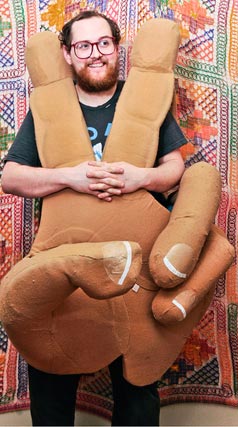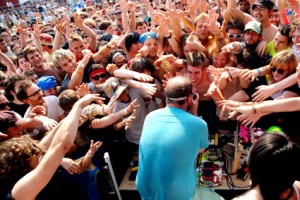Dan Deacon Live: Improvisation and Acceptance

I saw a remarkable show this weekend.
Melbourne’s Mistletone Records held a label showcase called Summer Tones across Australian venues.
The Brisbane show at The Zoo comprised Mistletone artists The Ruby Suns, Lawrence Arabia, High Places, Beaches and Dan Deacon [pictured right].
Deacon’s headlining performance was remarkable because he got the audience to do ridiculous things.
At one point, hundreds formed a human spiral by running around The Zoo’s central staircase.
Then there was a mass hands-behind-back dance-off.
Then there was a human tunnel that went downstairs and spanned the backstage area.
Each of these ridiculous, hilarious activities were performed under the guise of acceptance.
In 2005’s Blink, Malcolm Gladwell discusses the structure of spontaneity that characterises successful improvisational comedy groups.
One of the most important of the rules that make improv possible, for example, is the idea of agreement, the notion that a very simple way to create a story – or humor – is to have characters accept everything that happens to them.
[…] As Keith Johnstone, one of the founders of improv theater, writes: “[…] In life, most of us are highly skilled at suppressing action. All the improvisational teacher has to do is reverse this skill and he creates very ‘gifted’ improvisers. Bad improvisers black action, often with a high degree of skill. Good improvisers develop action.” (p 114-115)
 Audience acceptance – the willingness to accept the performer’s wild, physical suggestions – is the difference between the average, static, one-way musical performance, and a memorable show that you’ll tell all your friends about.
Audience acceptance – the willingness to accept the performer’s wild, physical suggestions – is the difference between the average, static, one-way musical performance, and a memorable show that you’ll tell all your friends about.
Part orator, part evangelist, part electronic composer: the manner in which Deacon successfully fuses music and theatre is brilliant. As a performer, he is entirely convincing: how else would you get 200 people to chase each other around a staircase?
In a Rave Magazine interview, Deacon states his preference for booking smaller venues. This is presumably because acceptance and social proof – wherein people rely on the actions of others in unfamiliar social contexts – become more difficult to influence as the size of the crowd increases.
“It’s a rare occasion [when Deacon’s crowd-pumping antics don’t work], but it depends on the audience,” he continues. “The audience is there to have a good time and enjoy themselves. If not, their life sucks.”
(can’t find the article online – it’s on page 20 of Rave Magazine issue #880)
Of course, Deacon’s highly interactive, personal approach to live performances can’t work for every artist or band.
Nor should it. It wouldn’t be remarkable if everyone did it. Instead, it’d be boring.
The same way that a purple cow only sticks out because the other cows aren’t purple.
There’s an excellent Citypaper article here that further discusses Deacon’s live show and how its outlandish nature – which lends itself to being shared online through photo and video – attracts what writer Rjyan Kidwell terms ‘voyeurs’ . Excerpt:
“As long as the crowds don’t become too rowdy or violent, I’m excited for my audience to grow,” he said. It sounds clear to me that Deacon has big ideas about what can happen when large groups of people get together in one room, but that he expects the audience to trust and commit completely to his leadership if something transcendent is to be achieved. [Citypaper]

> Nor should it. It wouldn’t be remarkable if everyone did it. Instead, it’d be boring.
And here you touch on an important principle of advertising — overuse equals abuse. You do something to stand out from the crowd — to differentiate you message — but soon or late everyone adopts it. Once that happens, your POD disappears.
D.